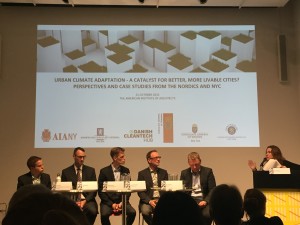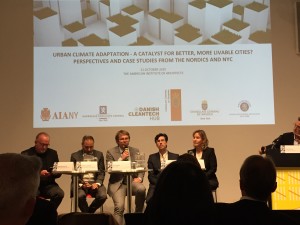
Last week, Talisen attended the American Institute of Architects’ (AIA) Urban Climate Adaptation event. With the growing public acknowledgement of rapid ice melt, rising sea levels, and the host of problems that face urban environments across the globe, the AIA’s event focused on fostering a conversation on what is being done currently and the future directions of our cities. Two panels of leading architects, policy-makers, and educators from across several Nordic countries and the U.S. exchanged ideas and information on how to make our built environment a better place. In case you missed the event, here were the top five takeaways:
New York City and the City of Copenhagen have formed an alliance to exchange ideas on climate change.
The two cities have leading individuals working together to trade ideas and offer support on infrastructure projects and development that will better protect our cities against the effects of climate change. New York’s Climate Program Director, Alan Cohn, and Jens Kramer Mikkelsen, (who is in charge of the Copenhagen Port Authority and a former Lord Mayor of Copenhagen for fifteen years) are on the vanguard of this effort.
The use of dredging to protect our cities’ people and infrastructure is a reality.
Sweden’s Sander Schuur of White Arkitekter AB worked in unison withFor a Resilient Rockaway (FARROC) to create a recovery plan for the tragedy-stricken area of Far Rockaway. Named the “Arverne East” complex, the design calls for two vegetated islands and two submerged sandbars, among a completely new boardwalk and residential area. These series of islands and sandbars will divert excess water to areas concentrated in bioswales (landscape features designed to filter, absorb, and divert excess water). Subsequently, the boardwalk will be angled into sections that will take the brunt of the water diverted by the islands.

To make a change, we need everyone to be part of the solution.
Demos Effect is a Finnish think tank. Juha Leppänen is the CEO of Demos Effect and specializes in harnessing the power of people to create an idea bigger and better than no one individual could ever stir up. Jeremy Siegel of Rebuild by Design’s the BIG team works to engineer resilient architecture with a keen focus on benefitting the community.Together, Leppänen and Siegel communicated the power of harnessing the people’s ideas to create something that is both practical and servile to the city. Known as “The Big U”, this wall-like structure would cover a large portion of lower Manhattan to protect against flood waters and provide integrated recreational spaces.
Biophilia (huh?) is an important part of our future.
Herbert Dreiseitl of Ramboll Group International brought everyone’s attention to the topic of “biophilia”, also known as man’s instinctive desire to connect with all the living things in his or her environment. As the realm of technology expands we as individuals become more and more detached from nature. In that sense, Biophilia in architecture recognizes the importance of incorporating and working with nature to create the ultimate unity between man and our environment. An important consideration when building any project.
Goal: Produce more energy than we use
Camilla Moneta of Snohetta Oslo spoke extensively about her experience in building the first “Powerhouse” in Norway. The idea of a Powerhouse is to use an existing structure and convert it into a building that has the same physical appearance as always but produces more energy than it uses. If we can accomplish this in all the buildings around the city, we would be living in a much healthier, more sustainable environment. Let’s get there!
Overall, the discussion focused on bringing dynamic individuals together from two unique countries to share knowledge and solutions to some of the many problems that our cities face today. More than anything, it proved that we all have a part to play in making the world that we want to live in. Moving into 2016, Talisen is dedicated to progressing its part in the process!
